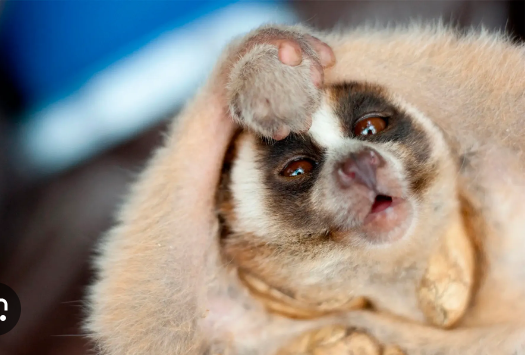
Slow lorises are cute, but they are one of the world's few venomous mammals.
The slow loris is a small, wide-eyed primate with a teddy bear-like appearance and may seem cuddly at first glance. But, this adorable-looking primate carries a venomous bite, a trait shared with some of the world's deadliest snakes.
These nocturnal primates, known for their gentle demeanour and slow, deliberate movements, are found in the tropical forests of Southeast Asia.
They are skilled hunters and climbers, relying on stealth and patience to catch their prey.
The venom
Unlike other primates, slow lorises have a pair of modified brachial glands located at their elbows. These glands produce a toxic secretion that mixes with their saliva, and when they bite, this venom is injected into their prey or potential threats. While not as powerful as that of snakes, the venom can cause intense pain, swelling, and even anaphylactic shock in some cases.
To produce venom, slow lorises raise their arms above their head and quickly lick venomous oil-secreting glands on their upper arms—the venom then pools in their grooved canines, sharp enough to slice into bone.

According to Anna Nekaris, a primate conservationist at Oxford Brookes University, slow lorises' bites can lead to severe consequences: The result of their bite is really, really horrendous. It causes necrosis, so animals may lose an eye, a scalp, or half their face.
Scientists are still studying the exact composition of the venom and its evolutionary purpose.
Dr Bryan Fry, a biochemist and Associate Professor at the University of Queensland, specialising in slow lorises at the Cikananga Wildlife Rescue Centre in Indonesia, highlights, “Slow lorises are the only known primates with venom, and they’ve been virtually unstudied.”
Purpose of the venom
But why would a primate need venom? Apparently, the slow loris use it for both hunting and staying safe. In hunting, it can immobilise prey, ranging from insects to small mammals, and even birds. When faced with danger, slow lorises raise their arms defensively, delivering a bite that can deter predators.
Another theory suggests that venom plays a role in intraspecies competition, helping slow lorises establish dominance and defend their territories. The venom incapacitates rivals, allowing the winning loris access to resources such as food and mates.
Read Full Story




















Facebook
Twitter
Pinterest
Instagram
Google+
YouTube
LinkedIn
RSS